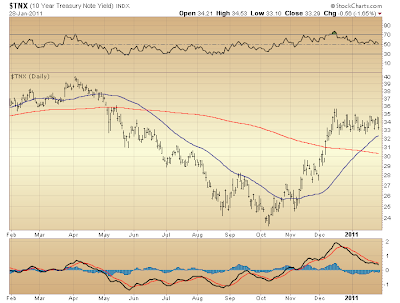Here we are in the first month of the year 2011 and before our eyes in the mainstream financial media (CNBC) are stories asking "Could the Federal Reserve Become Insolvent?"
Forget about such sophistry as concludes, "Almost by definition, the answer is no." Rather consider that, something serious — something essential — is in question and apparently needs addressing. Otherwise, why would a story like this appear in the mainstream at all?
Those who accuse the financial press of promoting a self-serving bias should take notice. A red flag is being raised. Fair warning is given at a time when solvency, indeed, is a fair question...

A mountain of debt has been grown over the past thirty years. (What you see above is only a fraction of it, but you get the picture. Debt's increase has been parabolic.)
Now, ask yourself. Have increased efficiencies been built into the physical economy (using this debt to finance the added capacity) assuring easy — relatively worry-free — repayment of this massively increased debt, as this surely will come due?
Were this the case, then there is no worry. In our midst would be capacity to easily sustain this increased debt taken on over the past thirty years and, indeed, increase it further!
Yet, instead, we find in the mainstream this need to address the Federal Reserve's solvency. At the same time is a growing push to cut government budgets — local, state, and federal — solely venturing to prop up the Fed's backstop (namely, the U.S. Treasury) whose size right now has ballooned into the tens of trillions of dollars (on- and off-balance-sheet) committed to a banking and financial system whose very solvency requires increasing support.
No wonder, then, we see concern for risk to the Fed's balance sheet were interest rates to rise. Let's consider this risk...

No worry, a new arrangement has the U.S. Treasury fronting for any losses the Fed suffers.
Yet no matter how you feel about this "accounting tweak" — whatever perspective feeds your sense about "the full faith and credit of the U.S. Treasury" — when extraordinary steps such as these are required, prudence advises an investor exercise extreme caution.
Again, bottom line is whether the physical economy possesses capacity to grow at a pace making the servicing of financing facilitating this growth seamless and mutually beneficial. Despite the U.S. Treasury entering into the fray and directly backstopping the banking system with its prop of the Federal Reserve, wealth generated by increasing economic productivity still must be forthcoming if Treasury's backstop is to succeed. Otherwise, it only is a matter of time before the U.S. Treasury's solvency is called into question, as well.

They say stocks historically offer superior returns because there somehow are greater risks associated with owning stocks. This is on account of their being at the bottom rung of the capital structure providing finance to the economy.
Yet if you ever wondered what circumstance might be present when risk owning common stocks is elevated, there is every reason to believe you are looking at it right now. With questions being raised in the mainstream about the solvency of lenders-of-last-resort — these exist at the top rung of the capital structure — and this at a time when a consensus of interests rather deny any risk, prudence advises such skepticism toward stocks as shuns their ownership until today's often irrational denial of solvency risk inevitably becomes tomorrow's equally irrational fear for a threat that, by then, will have passed.
Conditions today simply reveal how the spirit of greed stands ever-ready to be washed away with blood in the streets. What might come of this bath — what had better develop that the solvency of lenders of last resort might be secured and again go unquestioned — is for another day.
* * * * *
© The Risk Averse Alert — Advocating a patient, disciplined approach to stock market investing. Overriding objective is limiting financial risk. Minimizing investment capital loss is a priority.
Analysis centers on the stock market's path of least resistance. Long-term, this drives a simple strategy for safely investing a 401(k) for maximum profit. Intermediate-term, investing with stock index tracking-ETFs (both their long and short varieties) is advanced. Short-term, stock index options occasionally offer extraordinary profit opportunities when the stock market is moving along its projected path.
Nothing is set in stone. Nor is the stock market's path of least resistance always known. More often than not, there are no stock index option positions recommended.
 There's an easy way to boost your investment discipline...
There's an easy way to boost your investment discipline...Get Real-Time Trade Notification!



















